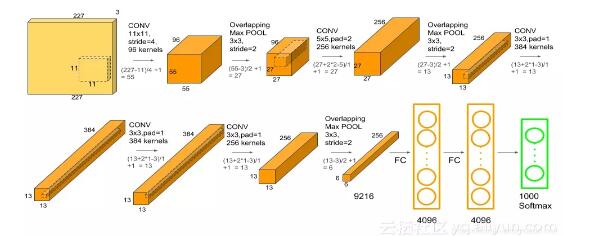PyTorch实现AlexNet示例
PyTorch: https://github.com/shanglianlm0525/PyTorch-Networks

import torch
import torch.nn as nn
import torchvision
class AlexNet(nn.Module):
def __init__(self,num_classes=1000):
super(AlexNet,self).__init__()
self.feature_extraction = nn.Sequential(
nn.Conv2d(in_channels=3,out_channels=96,kernel_size=11,stride=4,padding=2,bias=False),
nn.ReLU(inplace=True),
nn.MaxPool2d(kernel_size=3,stride=2,padding=0),
nn.Conv2d(in_channels=96,out_channels=192,kernel_size=5,stride=1,padding=2,bias=False),
nn.ReLU(inplace=True),
nn.MaxPool2d(kernel_size=3,stride=2,padding=0),
nn.Conv2d(in_channels=192,out_channels=384,kernel_size=3,stride=1,padding=1,bias=False),
nn.ReLU(inplace=True),
nn.Conv2d(in_channels=384,out_channels=256,kernel_size=3,stride=1,padding=1,bias=False),
nn.ReLU(inplace=True),
nn.Conv2d(in_channels=256,out_channels=256,kernel_size=3,stride=1,padding=1,bias=False),
nn.ReLU(inplace=True),
nn.MaxPool2d(kernel_size=3, stride=2, padding=0),
)
self.classifier = nn.Sequential(
nn.Dropout(p=0.5),
nn.Linear(in_features=256*6*6,out_features=4096),
nn.ReLU(inplace=True),
nn.Dropout(p=0.5),
nn.Linear(in_features=4096, out_features=4096),
nn.ReLU(inplace=True),
nn.Linear(in_features=4096, out_features=num_classes),
)
def forward(self,x):
x = self.feature_extraction(x)
x = x.view(x.size(0),256*6*6)
x = self.classifier(x)
return x
if __name__ =='__main__':
# model = torchvision.models.AlexNet()
model = AlexNet()
print(model)
input = torch.randn(8,3,224,224)
out = model(input)
print(out.shape)
以上这篇PyTorch实现AlexNet示例就是小编分享给大家的全部内容了,希望能给大家一个参考,也希望大家多多支持【听图阁-专注于Python设计】。